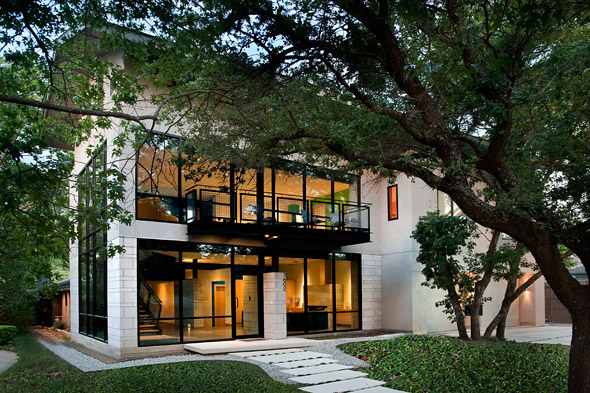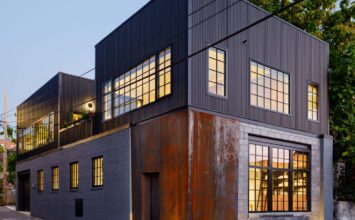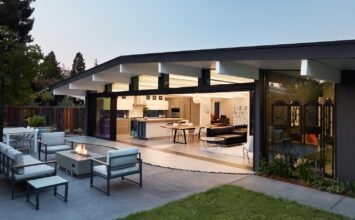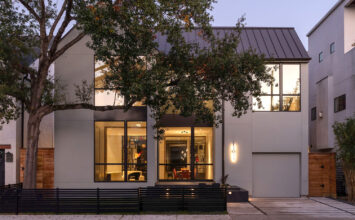This 100+ year old coach house was renovated and transformed inside and out into a stunning primary residence in Dupont Circle
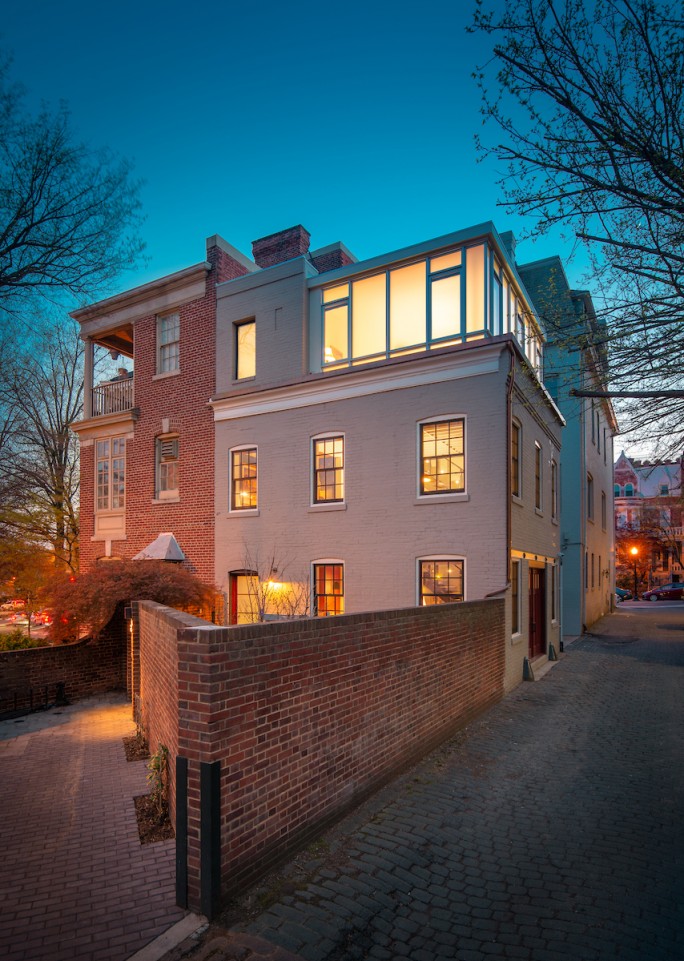
“Coachhouse” sits on an angled corner lot, sandwiched between an alley and a major avenue, in the Dupont section of Washington D.C. Originally built around 1910, it was historically associated with the adjacent mansion built in 1905. In 1960 (approx.), the coach house was converted to residential use and subdivided to be on its own lot. The district in which it resides was designated as an historic district in the 1980s.
The fairly small building stood just two stories tall as originally built. Within context of the neighborhood, this height was dwarfed by the elevations of the surrounding large townhouses that range in height between three and five stories. It measures just 25’ x 22’, but comprises robust load-bearing masonry and wood frame construction. The building is set back from the property line with a courtyard enclosed by a 6’ high brick wall; a second, lower brick wall separated the single-car parking space from the sidewalk. Coachhouse has no rear yard and no windows on the rear property line, thus it is dependent on the alley and the avenue for light and view.
The owners of Coachhouse decided it was time to downsize from the large suburban home where they raised two daughters into this smaller city dwelling that had been in the family since 1960. While the building has undergone renovations and remodels over the years, it was better suited as a rental and not in the best shape to be a primary residence. The clients turned to Amy Gardner and her team at Gardner Architects for help in turning Coachhouse into their new, old home.
The design goals for Coachhouse included the following:
– Add and create an entire third floor (which required working through Zoning and the Historic Preservation Review Board for permission).
– Follow the principle of the second man in shaping an addition
– Enhance the diminutive scale of the home and give it presence within the neighborhood
– Address the foreground of Coachhouse
– Create a modern kitchen
– Bring light in along the western windowless wall
– Embrace a sustainable agenda
And finally, the owners needed a home whose character could combine several identities — part coachhouse, raw and exposed; part repository for the owners’ extensive and eclectic object collections; and part modern sleeping porch (third floor).
Right from the street, the home’s changes can already be seen. Embracing the principle of the second man, Coachhouse’s allegiance to its neighboring house has been defined by mirroring the configuration of solid mass and sleeping porch; the latter comes in the form of the third floor “beacon,” a modern recreation of a sleeping porch. This third floor raises Coachhouse’s profile and brings it up to scale with the surrounding homes.
Addressing foreground and neighborhood presence goals, the courtyard, driveway, and edge of the property have also been redesigned. While the 6’ brick wall closer to the home has not been changed, the second, lower brick wall (closer to the street) has been replaced by a decorative iron fence and small garden panel with saplings and shrubs. This completely opens the view to the repaved driveway and brings character and curb appeal to the edge of the property at the property line.
Passing through the courtyard, visitors enter the home’s front door, which has remained in place. The stairs, however, have changed. The original configuration placed the staircase to the second floor straight ahead from the entrance. The stairs have been shifted, turned 90˚ to the adjacent wall and now, visitors walk into this “tiny great room” by stepping immediately into the kitchen… and what a kitchen it is!
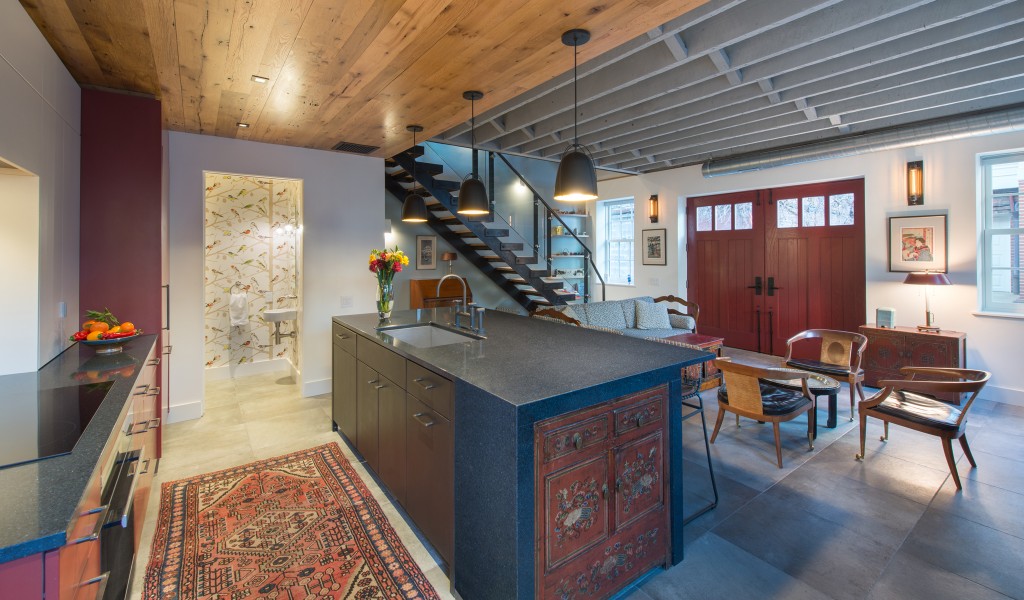
Flooring on this ground level is radiant heated porcelain tiles that look like concrete. Engineered reclaimed white and red oak serve as the kitchen’s dropped ceiling above. The kitchen island houses the sink, dishwasher, and storage on the cooking side; there are stools for counter-style eating on the room side. A china cabinet was built-in to the side of the island and is immediately visible upon entering the home. Decorative fixtures hanging above the island and recessed LEDs in the ceiling provide kitchen lighting.
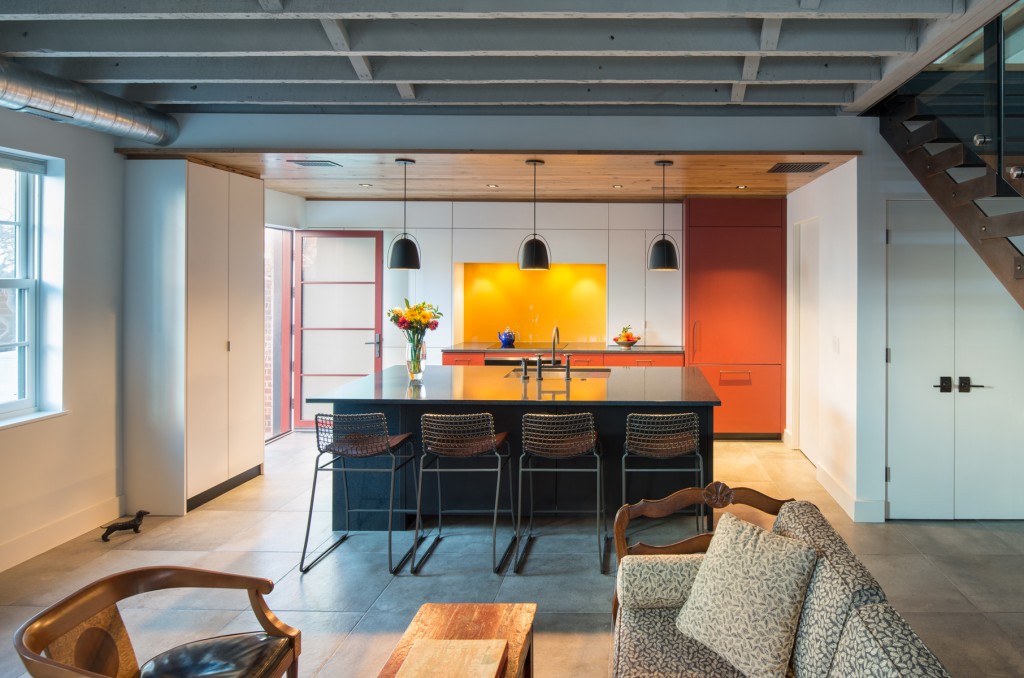
For color, Chinese blue countertop is used throughout the kitchen and completely covers the island (top and west side). Chinese red cabinets (and red paneled refrigerator) and a yellow/gold back-painted glass backsplash make for a palette of colors that is exquisite. When combined with the “concrete” flooring below and oak above, this kitchen is simply stunning.
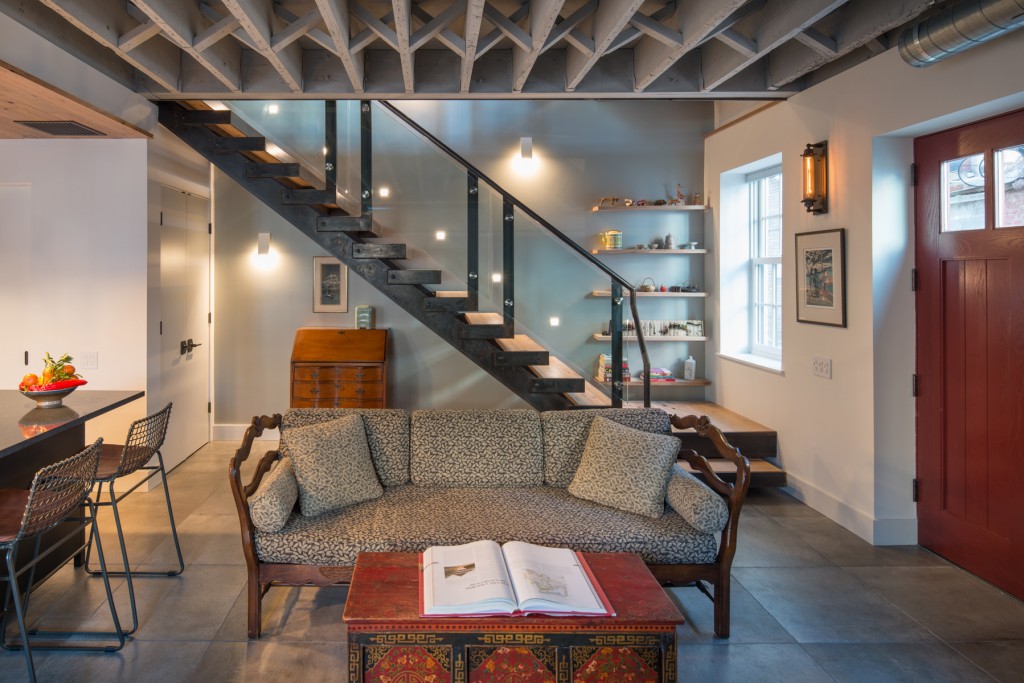
Adjacent to the kitchen is a small powder room. Stepping away from the kitchen area and into the living space, the oak ceiling gives way to exposed structure and ducts. The furniture visitors will see throughout the home are all vintage pieces found “here and there over the years.” In addition, there are lots of collectibles and eclectic objects to be spotted, as well as some fantastic pieces of art on the walls. This incredible juxtaposition of a space designed with modern principles in mind, highlighted by industrial touches like the exposed ceiling and “concrete” floor, filled with vintage furniture, and inspired by Chinese colors really makes this space incredibly unique and rather dazzling.
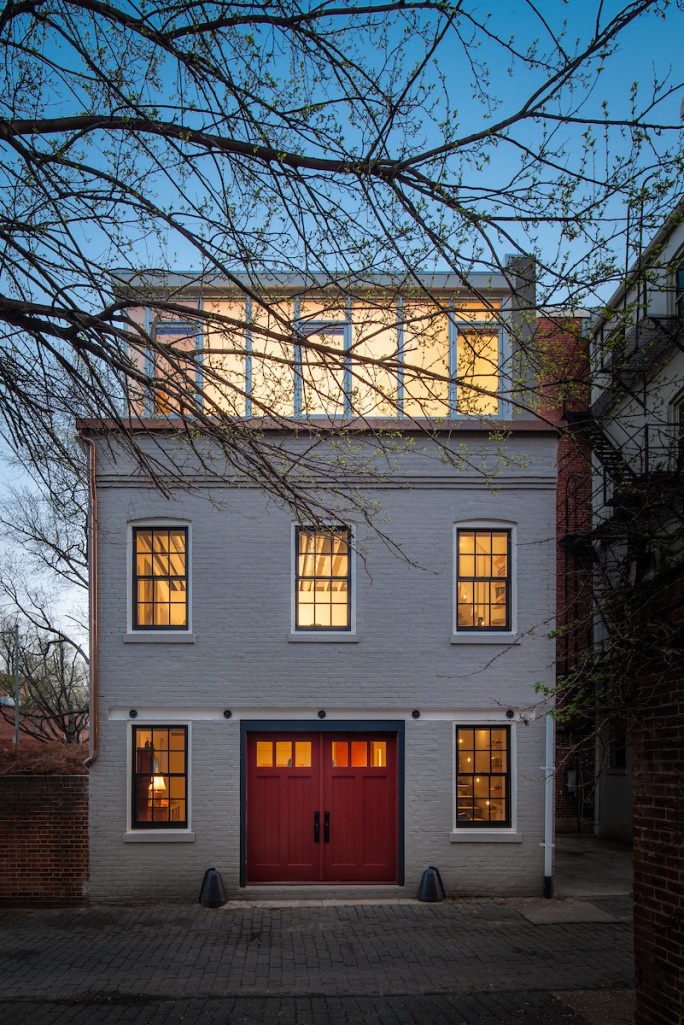
A final big change made in this room was bringing the coach house doors back. In a previous renovation, the doorway had been completely bricked in. It has been reopened and new doors installed. On a beautiful spring day, or a cool summer evening, opening the doors turns this living room into an indoor/outdoor space.
Raw steel framed stairs with oak treads and a modern steel and glass railing will bring guests up to the second floor. Simple shelves built into the wall at the bottom and top of the stairs showcase some of the owners’ collectibles.
The space up here is as elegant as it is open. The reclaimed white and red oak used as the kitchen ceiling is used as the flooring for the entire second and third levels. A couch (which can comfortably accommodate an overnight guest) and an antique desk fill the space and more artwork covers the walls. There is a closet at the top of the stairs and a small office nook for working at home; sandwiched in-between these two spaces is a full bathroom that features Moroccan tiles and the same porcelain “concrete” flooring as downstairs (slightly different color). This bathroom has a very classic feel with darker tiles accented by the dark painted hardware.
Visitors can walk past another set of shelves with collectibles up a set of stairs -identical to the first set- to the brand-new third floor “interior” sleeping porch. The oak floors are repeated, but everything else about this new addition leaves the antiques behind and embraces the modern. To meet the goal of bringing lighting into this windowless side of the house, skylights were placed directly above the staircase, allowing natural light to filter down to the middle floor.
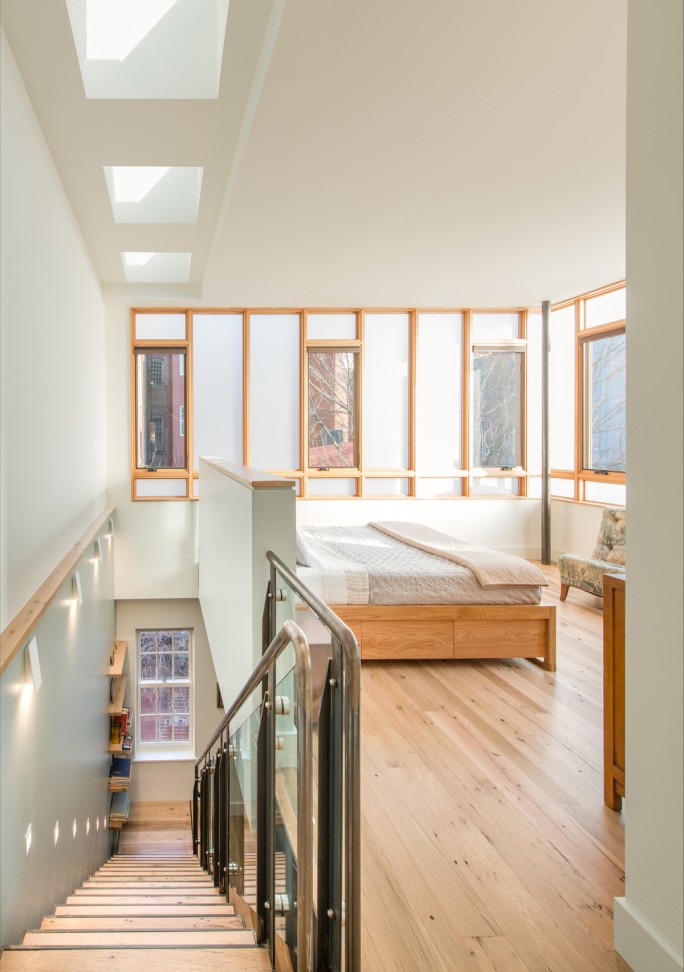
The northern and eastern walls (facing the alley and avenue) are wood framed glass, giving the feeling of a sleeping porch rather than a traditionally enclosed bedroom. Most of the panes are sandblasted, about ¼ of the glass is transparent vision glass. Between the skylights above, glass walls, white paint, and light-colored floors, this space is flooded with natural light and glows night and day.
The layout is simple. A closet at the top of the stairs holds personal belongings and the furniture in the bedroom is minimal. The real treat on this top floor is the master bathroom and its gloriously large walk-in shower. Many of the same black-painted fixtures are used again here, but the space is lighter and more modern than the companion bathroom below.
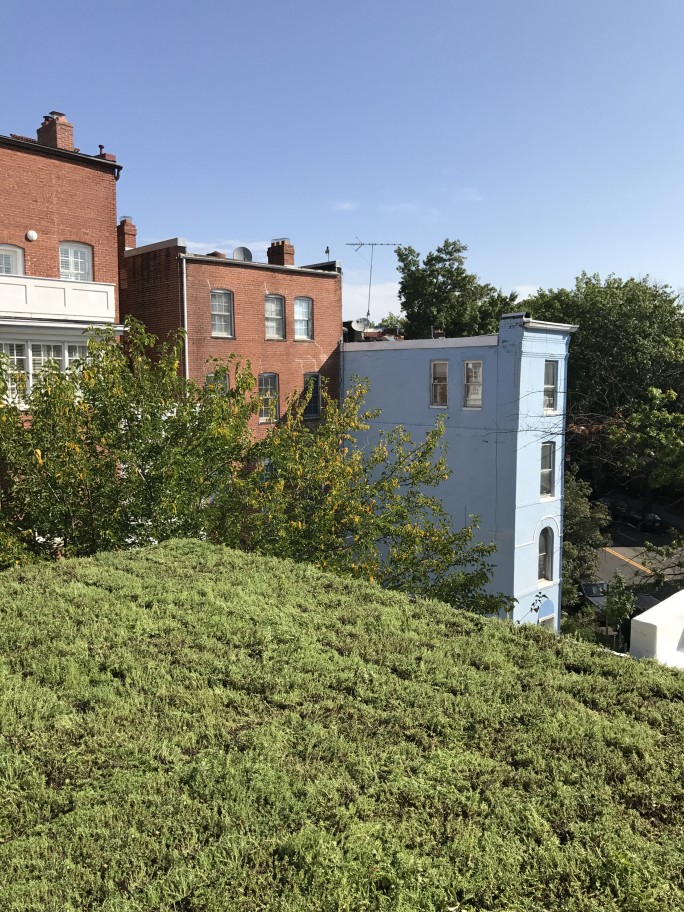
The final piece of this excellent home is an area not easy for visitors to get to: the roof! Because Coachhouse has no place for storm water, it has been equipped with a green/living roof.
Gardner Architects’ transformation of this two-story building into a modern three-story urban home is absolutely stunning. The contrast between the modern architectural design, vintage furniture, eclectic collectibles, materials used, and palette of colors makes this an incredibly unique and amazing home in this vibrant neighborhood of our nation’s capital.
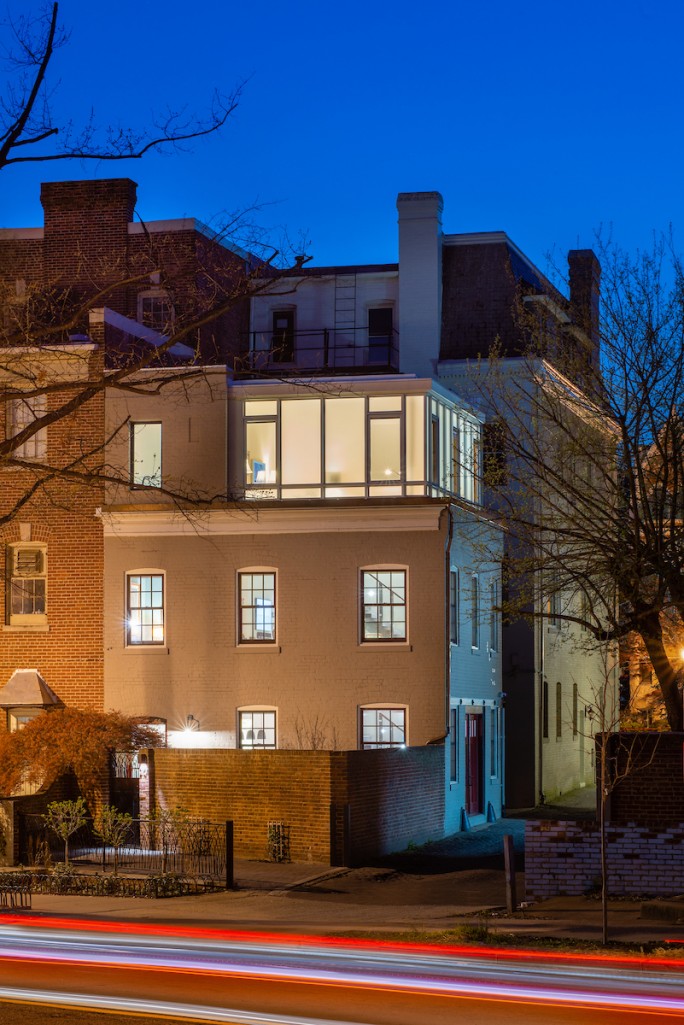
Gardner Architects, LLC
Based in: Silver Spring, Maryland
Contractor/Builder: Added Dimensions, Inc
Landscape Architect: Jordan Honeyman Landscape Architecture
Kitchen: Jennifer Gilmer Kitchen & Bath
Photo Credit: John Cole Photography
Project neighborhood: Dupont Circle
Number of Bedrooms: 1
Number of Bathrooms: 2 ½
Approximate Square Footage: 1,650
Original build: 1910 (est.)
Renovation: 2018
